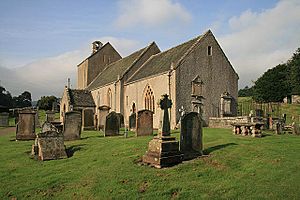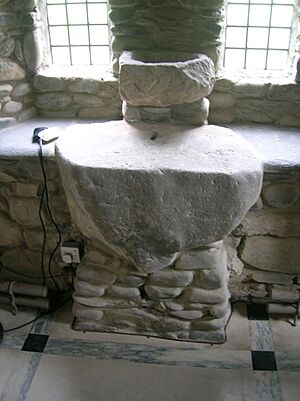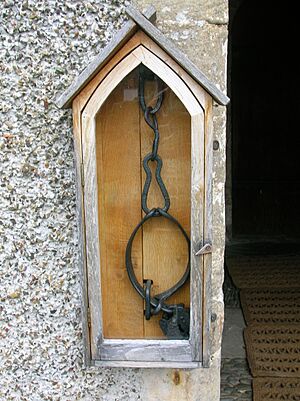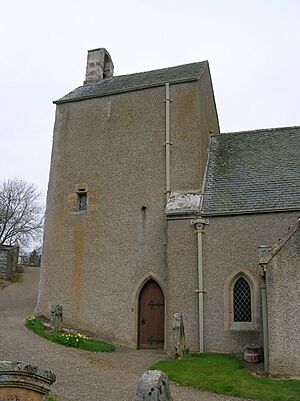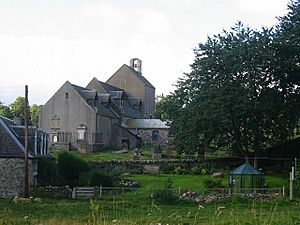Stobo Kirk facts for kids
Stobo Kirk is a very old church that belongs to the Church of Scotland. It's named after St Kentigern, also known as St Mungo. You can find it near the B712 road, just 6 miles southwest of Peebles in an area called the Scottish Borders Council. The church stands close to where the River Tweed meets the Easton Burn.
Contents
History of Stobo Kirk
How the Church Began
People believe there has been a church on the spot where Stobo Kirk stands today since the 500s. St Kentigern, or St Mungo, started many churches when he was a leader in the ancient kingdom of Strathclyde. Stobo is thought to be one of the churches he founded.
Stobo was once the main church, like a "mother church," for several smaller churches or chapels. These included churches in places like Dawyck, Drumelzier, Tweedsmuir, and Broughton.
Medieval Times and Changes
A new church, which is the ancestor of the building we see today, was built in the 1100s. It's a bit unusual because it faces northeast to southwest, instead of the usual east to west.
During the 1400s and 1500s, many Scottish people were getting tired of the Roman Catholic Church's rules. The church had become very rich, but most people were still poor. Many people wanted to change the church in Scotland. The people of Stobo felt the same way. When their church leader, Adam Colquhoun, was replaced by one of his two sons, it made people want a reformed church even more.
After the Reformation
Stobo Kirk was part of the Diocese of Glasgow until the Protestant Reformation. This was a big change when many people in Europe broke away from the Roman Catholic Church to form new Protestant churches. Stobo Kirk was lucky because it kept much of its original 1100s building, including windows, the main hall (called the nave), and the area around the altar (called the chancel). Many other Roman Catholic churches were destroyed after the Reformation, but Stobo Kirk was not.
The church tower was made taller in the 1500s. Then, in 1863, a famous architect named John Lessels did a lot of important repair work. More major repairs happened in 1929. While the outside of the church might not look very welcoming, the inside is full of interesting history and character.
The Legend of Merlin
There's a famous story that says St Kentigern helped Myrddin Wyllt (also known as Merlin, the famous wizard from the stories of King Arthur) become a Christian. The legend says Kentigern baptized Merlin on a large rock near Drumelzier. Merlin had run away to the forest after a battle in 573. There's a big rock at that spot called the 'Altar Stone'. A beautiful stained glass window in Stobo Kirk shows this special event.
Inside Stobo Kirk
Both the church building and its graveyard are considered "B listed." This means they are important historical buildings that need to be protected.
The Porch
The porch was added to the church in the late 1400s or 1500s. Look closely at the left side of the doorframe, and you'll see grooves. These were made by students sharpening their slate pencils before class. They might also have been made by people sharpening arrowheads before weekly archery practice. Archery became a required activity after the sad Battle of Flodden.
The main entrance into the nave is from the 1100s and is called a Norman entrance. The door itself is made from a single piece of Cedar of Lebanon wood, which came from the nearby Dawyck estate.
On the outside of the porch, you can see old iron collars called Jougs. These were used to punish people from the parish who misbehaved, up until the 1700s.
During the church's repair work, a damaged Celtic cross was found hidden in the stone walls. A rebuilt version of it is now displayed in the nave. You might also notice some red paint on the stonework. This is a reminder that churches before the Reformation were often brightly painted inside.
North Aisle Chapel
This chapel was rebuilt in 1928 in a style that reminds people of the Arts and Crafts Movement. At the time, people mistakenly thought this was where Saint Kentigern's Chapel used to be. The chapel has a standing stone built into its wall. It was probably a special chapel from the 1400s where prayers were said for the dead. Inside, you can see old stone slabs, including one for Robert Vesey from the 1300s, and others for a local miller and a knight in armor. The altar stone here might be connected to the story of Merlin becoming a Christian.
Important Graves
During the 1928 repairs, three old tombstones were moved from the floor to the chapel walls. The most important one has a Latin message that says, "Here lies Mr Robert Vessy, who was once the vicar of Stobo and died on May 10, 1473." Another stone shows a full figure of a man wearing some armor with a sword, from the late 1500s. The third stone is not complete.
The Tower
The church tower might have been built in the 1100s, but it has been rebuilt several times over the years. It used to lead to the 'Laird's Loft', which was a special seating area for the local lord. Today, the tower holds a meeting room and the vestry, which is where the clergy prepare for services. You can also see windows that were blocked up, likely in the 1500s.
Brass Hanging Lamps
The Balfour family, who lived at Stobo Castle, gave several brass hanging lamps to the church. One of these lamps has been identified as being made in Nuremberg, Germany, by a craftsman named Hans Muller between 1693 and 1701. The other lamps are either copies or were made by other craftsmen from Nuremberg.
'Stobo Kirk' by James McIntosh Patrick
Stobo Kirk has been featured in paintings by a Scottish landscape painter from the 1900s named James McIntosh Patrick (1907–1998). One of his most famous paintings is simply called 'Stobo Kirk' (painted in 1939) and can be seen at the National Galleries of Scotland in Edinburgh.
See also
- Dawyck Chapel
- List of places in the Scottish Borders
- List of listed buildings in Stobo, Scottish Borders


